

Off the Food Grid. Richard Lazzara - #TethysSeaSalts. Dolphins Can Call Each Other, Not by Name, But by Whistle. Walking with Beasts : Whale Killer - Episode 2. 180,000-Year-Old Mutation Allowed Humans to Become Vegetarians and Move Out of Africa : Science/Tech. Early humans were able to move from Africa after a single genetic mutation allowed them to become vegetarians, scientists claim.

The switch, which allowed humans to process vegetables, meant that humans were able to move away from water sources and spread across the continent. A team of geneticists compared DNA sequences from a variety of people around the world to see how different populations relate to one another and when they have gone their separate ways. The scientists found that a key genetic variant gave humans the ability to convert fats from plants into essential nutrients for the brain. The study, published in the journal Public Library of Science (PLOS), suggests that the gene mutation would have allowed Homo sapiens to leave the bodies of water in central Africa where they ate fish. Homo sapiens first appeared 180,000 years ago but stayed around bodies of water in central Africa for almost 100,000 years. Himalayan Meltdown’ Wins Prize at Film Festival.
Mugger crocodiles in Iran. Mugger crocodile and its distribution in Iran: By Asghar Mobarak and Elham Abtin Courtesy of Wildlife Middle East Mugger or Marsh crocodile (Crocodylus palustris) is a medium to large crocodile (max. length approx. 4-5 m) and has the broadest snout of any living member of the genus Crocodylus.
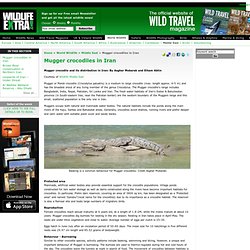
The Mugger crocodile's range includes Bangladesh, India, Nepal, Pakistan, Sri Lanka and Iran. The fresh water habitats of Iran's Sistan & Baluchestan province (in South-eastern Iran, near the Pakistan border) are the western boundary of the Muggers range and this small, scattered population is the only one in Iran. Muggers occupy both natural and manmade water bodies. Palaeobiology and Biodiversity Research Group, Department of Earth Sciences, University of Bristol. Today Haţeg is a landlocked town within the Eastern European country of Romania but 70 million years ago during the late Cretaceous it was an island within a shallow sea that covered much of today's Southern Europe.

At almost 80,000 square kilometers in size it was similar to today's Caribbean island of Hispaniola (Csiki 2005). It was formed by uplift caused by the closing of the Tethys Ocean by the collision of the African and Eurasian plates, a collision which is also responsable for mountain chains in both Southern Europe and North Africa and a process which is still occuring today as Africa pushes North. This island contains one of the most studied late Cretaceous dinosaur fauna outside of North America. Wadi Al-Hitan (Whale Valley), Egypt. Geographical Location Wadi Al-Hitan (29° 15’ 13'' to 29° 23’ 56''N by 30° 00’ 41'' to 30° 10’ 06 E) is a World Heritage Site in the Western Desert 150 kilometers (km) southwest of Cairo and 80 km west of Faiyum in the Wadi el-Rayan Protected Area.

Dates and History of Establishment 1905: Fossil whales first discovered on the site; named Basilosaurus;1970s: Wadi el-Rayan lakes and wetland created by agricultural drainage from Faiyum;1980s: Geologists began to study the whale fossils, naming the area Whale Valley (Wadi Al-Hitan); 1989: Wadi el-Rayan Protected Area (WRPA) declared by Prime-ministerial Decree 943 under Law 102 of 1983 on Natural Protectorates;1997: Wadi Al-Hitan included as a Special Protected Area within the Wadi el-Rayan Protected Area by Prime-ministerial Decree 2954.
Area 25,900 hectares (ha), comprising a 20,015 ha core area with a 5,885 buffer zone. Land Tenure. New Prehistoric Crocodile Found in "Kitchen Counters" Fossils of a new species of ancient crocodile cousin have been found in limestone once destined for Italian kitchen countertops, a new study says. The ancient reptile's dolphin-like body. Illustration courtesy Davide Bonadonna. The fossils were originally discovered in a limestone quarry in Ferrara, Italy, in 1955 after workers sliced a huge block into four slabs and found the bones trapped inside. "When the owner noticed the bones, he decided to save" the slabs, said study co-author Federico Fanti, a geologist at the Museo Geologico Giovanni Capellini in Italy. The Early Earth and Plate Tectonics. GEOL 104 In the Shadow of the Dinosaurs: Pterosaurs, Marine Reptiles, Mesozoic Mammals, Mesozoic Plants. Origin of the Fuzzballs: The First 7/10ths of Mammalian History On land during the Mesozoic, there were plenty of organisms other than dinosaurs.
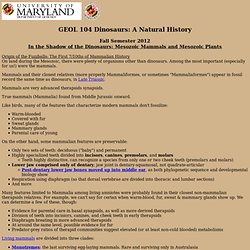
Among the most important (especially for us!) Were the mammals. Mammals and their closest relatives (more properly Mammaliformes, or sometimes "Mammaliaformes") appear in fossil record the same time as dinosaurs, in Late Triassic. Mammals are very advanced therapsids synapsids. Continental Drift - History Of Wegener's Theory - Continents, Earth, America, and Africa. At one time—estimated to be 200 to 300 million years ago—continents were united in one supercontinent or protocontinent named Pangaea (or Pangea, from the Greek pan, meaning all, and gaea, meaning world) that first split into two halves.
The two halves of the protocontinent were the northern continent Laurasia and the southern continent named Gondwanaland or Gondwana. These two pieces were separated by the Tethys Sea. Laurasia later subdivided into North America, Eurasia (excluding India), and Greenland. Gondwana is believed to have included Antarctica, Australia, Africa, South America, and India. Most ancient crocodile discovered, Aegisuchus witmeri. Artist's Rendering of Shieldcroc (Aegisuchus witmeri); Credit: Orginal artwork by Henry P.
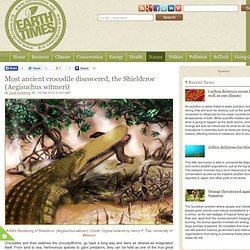
Tsai, University of Missouri. Global extinction: Gradual doom is just as bad as abrupt. A painstakingly detailed investigation shows that mass extinctions need not be sudden events.
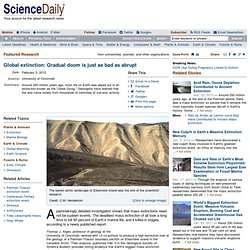
The deadliest mass extinction of all took a long time to kill 90 percent of Earth's marine life, and it killed in stages, according to a newly published report. Thomas J. Tethys Petroleum unveils official opening of new rail loading facility in Kazakhstan. 30th Jan 2012, 9:43 am by Deborah Sterescu.

Tethys announces completion of US$13 million private placement. Tethys Petroleum Limited today announced that it has completed a previously announced private placement of 26,062,975 Ordinary Shares for gross proceeds of US$13,069,187 million (the "Offering").
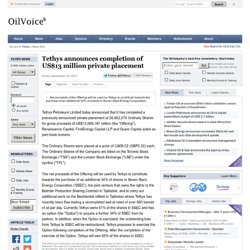
Renaissance Capital, FirstEnergy Capital LLP and Quam Capital acted as joint book runners. The Ordinary Shares were placed at a price of CAD0.52 (GBP0.32) each. The Ordinary Shares of the Company are listed on the Toronto Stock Exchange ("TSX") and the London Stock Exchange ("LSE") under the symbol ("TPL"). Animals Have Emotions, May Help People Understand Theirs. (EmaxHealth) - Have you ever felt like your dog or cat knows what you are feeling and empathizes with you?

Do you think other animals have emotions, and if they do, is it important? Tethys Oil announces strong Oman oil output. Tethys Oil makes discovery onshore Oman - World Oil. Tethys Oil makes discovery onshore Oman. Hunting for Fossil Rock in the Arabian Desert. Heavy snow halts Tethys oil transport in western Kazakhstan. Tethys « ferrebeekeeper. Andrewsarchus Skull at the American Museum of Natural History. Global Extinction Need Not be Sudden Events. Global Extinction Need Not be Sudden Events. Major events in Caspian countries' oil and gas industry for last week (Jan. 30- Feb. 4)
Azerbaijan and Italy discuss prospects of cooperation in energy sector.